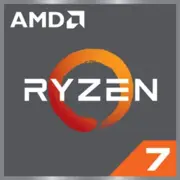AMD Ryzen 7 4700GE

AMD Ryzen 7 4700GE: An Energy-Efficient Processor for Versatile Tasks
A review for those who value the balance between performance and energy savings
Key Specifications: Zen 2 in a Compact Form Factor
The AMD Ryzen 7 4700GE processor, released in 2020, has remained relevant by 2025 due to its successful combination of features.
Architecture and Technology Process
- Zen 2: The architecture ensures high IPC (instructions per cycle) but falls behind Zen 3 and Zen 4 in cache-intensive tasks.
- 7 nm Technology Process: Energy efficiency is a priority— with a TDP of 65W, the processor generates less heat than 14nm counterparts (e.g., Intel’s 10th generation).
- 8 Cores / 16 Threads: Multithreading supports rendering, streaming, and virtual machines.
Performance
- Base Clock 3.6 GHz / Turbo 4.4 GHz: In Cinebench R23 tests, the processor scores approximately 12,500 points in multithreaded mode, similar to the Ryzen 7 5700G.
- Integrated Graphics: Although the exact model isn’t specified, it likely uses Vega 8 (512 streams). In Full HD gaming at low settings: CS:GO — 90-110 FPS, Dota 2 — 60-70 FPS.
- Geekbench 6: Scores 1521 (single-core) and 6361 (multi-core) — higher than Intel Core i7-10700 but lower than Ryzen 5 7600.
Key Features:
- Low power consumption — suitable for compact builds.
- PCIe 3.0 support (compared to 4.0/5.0 in newer models).
- Comes with a Wraith Stealth cooler (for basic cooling).
Compatible Motherboards: AM4 Socket and Chipset Options
Ryzen 7 4700GE uses the AM4 socket, providing access to a vast array of motherboards.
Recommended Chipsets
- B550: The optimal choice. Supports PCIe 4.0 for drives (but the processor works with PCIe 3.0), and memory overclocking up to 4000+ MHz. Example: MSI B550M PRO-VDH WiFi ($120–$140).
- A520: A budget option. No overclocking, but stable performance. Suitable for office PCs (e.g., Gigabyte A520M S2H, $70–$90).
- X570: Overkill but useful if planning to upgrade to Ryzen 9 5950X (ASUS TUF Gaming X570-Plus, $180–$200).
Important: BIOS updates may be required on motherboards released before 2020 to work with Ryzen 7 4700GE.
Supported Memory: DDR4 and Tuning Considerations
The processor works with DDR4, with a maximum official frequency of 3200 MHz. However, many motherboards support overclocking to 3600–3800 MHz in practice.
Recommendations:
- Use dual-channel kits: 2x8 GB or 2x16 GB.
- Memory speed is crucial for integrated graphics: upgrading from 2666 MHz to 3200 MHz yields a 15–20% FPS increase.
- Popular models: Corsair Vengeance LPX 3200 MHz ($50–$60 for 16 GB), Crucial Ballistix 3600 MHz ($65–$75).
Power Supply: How Many Watts Do You Need?
With a TDP of 65W, the processor is not demanding on the PSU, but it's important to consider other components:
- Without a discrete GPU: A 350–450W unit is sufficient (e.g., be quiet! Pure Power 11 400W, $60).
- With a GPU like the NVIDIA RTX 3060: A 550–650W unit is recommended (Corsair CX650M, $80–$90).
- Certification: 80 Plus Bronze or higher. Avoid cheap noname brands — unstable voltage can shorten component lifespan.
Pros and Cons: Who Is It Suitable For?
Advantages:
- Energy efficiency: Ideal for mini-PCs and systems with passive cooling.
- Integrated graphics: Replaces budget GPUs in office tasks and light gaming.
- Price: In 2025, the processor can be found for $180–$220 (new), cheaper than the Ryzen 5 8600G ($250–$280).
Disadvantages:
- No PCIe 4.0/5.0: SSDs and GPUs won't exploit full speeds.
- Outdated architecture: Ryzen 7000/8000 series on Zen 4/5 offers 30–40% more performance.
- Limited overclocking: The multiplier is locked (except for "X" versions).
Use Cases: From Office to Streaming
1. Office and Multimedia: Streaming 4K video, document editing, browsing with 20+ tabs — the processor handles tasks without lag.
2. Gaming: On integrated graphics — indie games and online projects (Hollow Knight, League of Legends). With a discrete GPU (e.g., RX 6600) — AAA games at medium settings in Full HD.
3. Work Tasks: Video editing in DaVinci Resolve, 3D modeling in Blender, code compilation.
Practical Example: A build with Ryzen 7 4700GE, 32 GB DDR4, RTX 3060 shows 98% CPU usage in Cyberpunk 2077 (1080p, medium settings), affirming its capability to work with modern GPUs.
Comparisons with Competitors
- Intel Core i5-12400 (6 cores/12 threads): Better in single-core tasks (Geekbench 6 ~1800), but worse in multithreaded tasks (Geekbench 6 ~6200). Price: $200–$220.
- Ryzen 5 7600 (Zen 4): 25–30% faster, but more expensive ($250–$280) and requires DDR5.
- Ryzen 7 5700G (Zen 3): More powerful graphics (Vega 8 vs. Vega 8 in 4700GE — a 10–15% increase), but costs more ($220–$240).
Conclusion: The 4700GE excels in the budget segment, where price and power consumption are crucial.
Building Tips
1. Case: Choose models with good ventilation (e.g., Fractal Design Meshify C Mini). A slim case like Silverstone ML09 works well for HTPC.
2. Cooling: The stock cooler is sufficient for basic tasks, but for memory overclocking or prolonged workloads, consider a tower cooler like the Cooler Master Hyper 212 ($35).
3. Storage: Use NVMe SSDs (e.g., Samsung 970 Evo Plus 1TB, $90) — even on PCIe 3.0, the difference with SATA is noticeable.
Final Conclusion: Who Should Choose Ryzen 7 4700GE?
This processor is a solid choice if you:
- Are building a PC for office or home with a limited budget.
- Want a quiet system with low power consumption.
- Plan to use the PC for light gaming without a discrete GPU.
- Need multithreading for work but aren't willing to overpay for Zen 4.
Alternative: If budget allows, consider the Ryzen 5 8600G — it offers a more modern architecture and RDNA 2 graphics. However, for many tasks, the 4700GE remains a cost-effective option even in 2025.
Basic
CPU Specifications
Memory Specifications
GPU Specifications
Miscellaneous
Benchmarks
Compared to Other CPU
Share in social media
Or Link To Us
<a href="https://cputronic.com/en/cpu/amd-ryzen-7-4700ge" target="_blank">AMD Ryzen 7 4700GE</a>